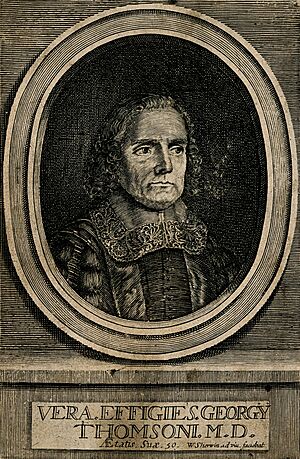George Thomson (physician) facts for kids
George Thomson (born around 1619, died 1676) was an English doctor and writer. He was a key person in trying to create a new group called the "College of Chemical Physicians." This group aimed to challenge the traditional Royal College of Physicians. Thomson did not agree with the old medical ideas of Galen. He also spoke out against common treatments like bloodletting (taking blood from a patient) and purging (making someone throw up). He also disagreed with the idea of curing sickness by using "contraries." Thomson famously performed a surgery on a dog, removing its spleen. This event caused a lot of discussion among scientists and doctors. It also questioned the popular medical ideas about the human body at the time.
Contents
A Doctor with New Ideas
Early Life and Education
George Thomson was born around 1619. He served as a soldier under Prince Maurice during the English Civil War. In 1644, he was captured by the parliamentarians at Newbury. He then spent some time in Fleet Prison, a jail in London.
After his release, Thomson wanted to get a license to practice medicine. However, the College of Physicians asked for a very high fee. So, he decided to get his medical degree (M.D.) from Leyden University in the Netherlands. He graduated on June 15, 1648. His main paper for this degree was called "Disputatio de Apoplexia." After his studies, Thomson rejected the old Galenic medicine. He became a strong supporter of the new ideas from Jan Baptist van Helmont.
Challenging Old Beliefs
Around 1656, Thomson performed a splenectomy (removing the spleen) on a dog. He successfully kept the dog alive for more than two years after the surgery. This was a big deal because it challenged the popular humoralist theory of the body. This theory suggested that the spleen was very important for balancing body fluids. Thomson's experiment caught the attention of many doctors and scientists in London. These included famous people like William Harvey and Robert Boyle.
During the Great Plague in 1665, Thomson stayed in London. He studied the symptoms of the plague very closely. He even dissected (examined inside) the body of a plague victim. In 1665, he published a book called "Loimologia: a Consolatory Advice, and some brief Observations concerning the present Pest." In this book, he criticized members of the Royal College of Physicians. He said they ran away from the city during the plague. He accused them of "leaving this great city destitute of their help, when it most needed it." This book led to a strong response from John Heydon.
Arguments Against Old Treatments
In 1665, Thomson also published "Galeno-pale, or a chymical Trial of the Galenists, that their Dross in Physick may be discovered." In this work, he argued that English doctors relied too much on old theories. He felt they did not value real-world experience enough. He also strongly spoke out against too much Bloodletting and purging, which were common treatments. He also disagreed with the idea of trying to cure diseases by using "contraries." This book also led to a reply from William Johnson.
In 1670, Thomson published another book against bloodletting. It was titled "Haimatiasis, or the true Way of preserving the Bloud." This started a new argument with Henry Stubbe. Thomson continued to write and publish his ideas in the following years.
Personal Life
George Thomson was married twice. His first marriage was on November 2, 1667, to Abigail Nettleshipp. His second marriage was on October 31, 1672, to Martha Bathurst.
A picture of Thomson, made in 1670 by William Sherwin, can be found at the beginning of some of his books.


